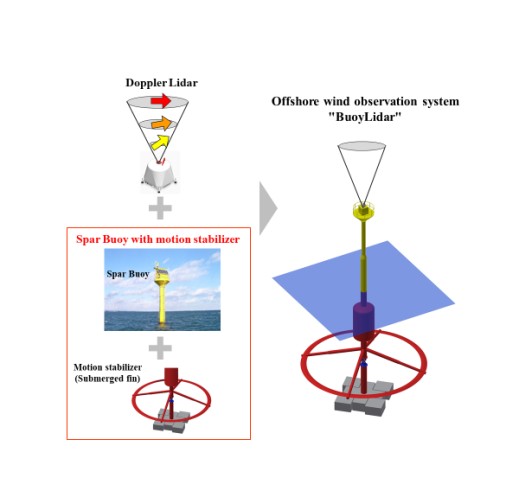Offshore Wind Observation System
Technology / Service Summary
<BuoyLidar> is a floating offshore wind observation system equipped a "Doppler Lidar" that captures reflected waves of laser light and measures vertical wind profile, with "Spar Buoy with motion stabilizer" that suppresses shaking caused by ocean waves.
Purpose
<BuoyLidar> enables direct observation of offshore wind conditions in a low-cost and short period, it also can be used for business developments (preliminary surveys, designs, construction, and maintenance) of offshore wind farms.
Feature
Direct observation of offshore wind conditions using the world's first technology equipped with a lidar on Spar Buoy with motion stabilizer.
Compact design realizes cost reduction and shortening of construction period.
Specifications for severe marine environment such as countermeasures against salt damage and rainfall.
Ensure stable power supply from fuel cells. Continuous operation record for 5 months without refueling.
Tension Leg Platform (TLP) enables <BuoyLidar> to fix at the installation point, it can reduce the burden on fishery personnel.
The Doppler Lidar is equipped with a motion stabilizer to eliminate the effects of ocean waves.
Expectations for turbulence measurement on the ocean. (We plan to apply turbulence measurement technology for lidar observation on land in the future)
Effect
The demonstration tests in the offshore area of Sakata, Yamagata Prefecture showed that <BuoyLidar> can reduce about 85% of the cost, compared to observations using offshore observation towers.
Controlled Substance
Applicable Regions / Countries
- Japan
- Southeast Asia
- Central/South Asia
- China/ East Asia
- Middle East
- Africa
- Oceania
- Europe
- Central/South America
- ASEAN countries
Indonesia,Cambodia,Singapore,Thailand,Philippines,Brunei Darussalam,Viet Nam,Malaysia,Myanmar,Lao PDR
Accomplishments
A total of 18 months in offshore of Sakata, Yamagata Prefecture, demonstration tests showed that <BuoyLidar> can reduce about 85% of the cost, compared to observations using offshore observation towers. We also confirmed that the acquisition rate of observation data at an altitude of 100m, which is important for offshore wind power generation, is 96.1%, enabling stable observation over a long period of time.
Related SDGs Goals
- 7. Affordable and Clean Energy
- 9. Industry, Innovation and Infrastructure
- 13. Climate Action



